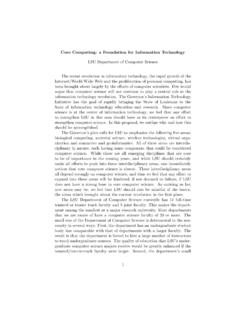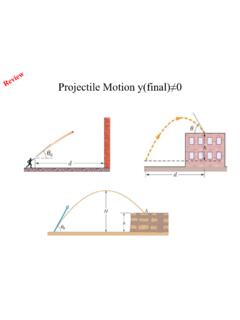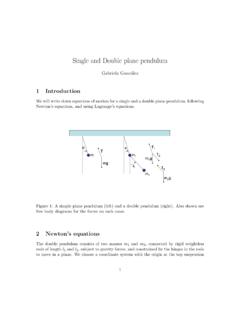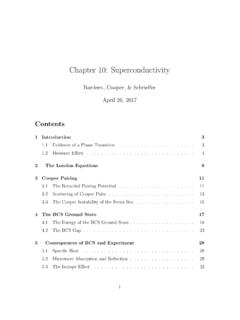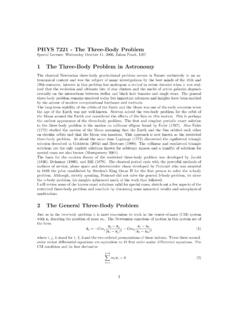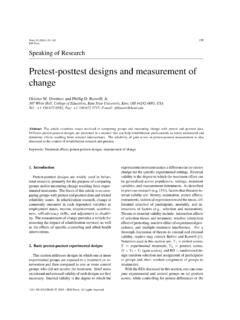Transcription of Wireless and Broadband Technologies
1 Wireless and Broadband Technologies 1. Introduction Advances in communication, device, and processor Technologies have led to the creation of a wide range of information devices: tiny wearable computers, ultralight laptops, personal digital assistants (PDAs) and cellphones, desktop computers and high- end servers. These advances have made internet a household word, given every American access to the treasures in the Library of Congress, enabled applications such as e-commerce and forever changed our everyday lives.
2 Future demands in voice, video, and data transmission, coupled with the mobility of our society, mandate the development of Wireless and Broadband networks. Advances in these Technologies will enhance the quality of communication through improved access, speed, and connectivity, enhance the quality of information technology applications, and make possible distance interaction in a realistic environment ( , distance learning and virtual reality). LSU has the opportunity and the foundation on which to build a center of excellence in Wireless and Broadband technology that will serve the educational and development needs of the state and carry out nationally competitive research.
3 This initiative is rooted in the Master Plan for Economic Development, Louisiana: Vision 2020, which has identified the Internet and telecommunications as components of a technology cluster targeted for development in the diversification of Louisiana's economy. The thrust is also in line with the goals of federal agencies promoting the information technology for the twenty-first century (IT2) initiative. This initiative, based on current strengths and perceived potential of reaching national prominence, proposes an integrated effort to address issues that push the state- of-the-art of Wireless and Broadband Technologies .
4 Figure 1 shows the relationships among the component areas of the proposed research. Networking focuses on means for a collection of computing and information devices to work together effectively. The Wireless and Broadband initiative involves all aspects of communications dealing with tetherless access ( Wireless ) of information, and high-speed information transfer ( Broadband ). Though the two terms are not mutually exclusive, Wireless is normally associated with lower frequencies (RF) while Broadband is associated with higher frequencies (optical).
5 Advances in Wireless and Broadband access depend on hardware developments in microelectronics, photonics, RF integrated circuits, and low-power design. The proposal is organized according to these topics. 1. 2. Wireless Communication Research and teaching in Wireless communication will encompass all aspects of Wireless communication systems including physical layer, multiple access protocols, local area networks, personal communication systems, and ad-hoc networks. This area will require four new faculty positions.
6 With the advent of new Technologies such as personal communication systems, local multipoint distribution systems and Bluetooth, different aspects of radio propagation need to be modeled, analyzed and measured. To cope with the limited available spectrum and to combat the high and fluctuating error rates in the radio channel caused by mulitpath fading, efficient modulation and error control strategies are required. Channel equalization, spread spectrum and multiuser detection are also required to mitigate the disruptive effects of the radio channel on the transmitted signal.
7 Development of smart antenna arrays will increase the capacity of the network allowing more users to access the network services. With ever increasing demand on the radio spectrum, efficient multiple access protocols must be designed to enable users to share the limited spectrum. Furthermore, as multimedia services are being moved to the Wireless environment, support of differentiated quality of service in the multiple access protocol becomes essential. Mobile ad-hoc and self-reconfigurable Wireless networks have become important research topics.
8 In many applications such as emergency management response and tactical battlefield where a central base station cannot be easily deployed, these networks can be deployed quickly and effectively. Software radio is an emerging technology in which the channel modulation waveforms are defined in software allowing simple implementation of multimode and multiband radios. Finally, system architecture issues need to be investigated. 2. Radio Propagation: Measurement, modeling and simulation of propagation effects in the radio channel for mobile, personal, broadcasting, and fixed applications.
9 Modulation and Coding: Design and analysis of power and bandwidth efficient modulation and error control strategies particularly for Broadband Wireless applications. Data Compression: Development of efficient data compression schemes for multimedia sources. Signal Processing: Analysis and implementation of signal processing algorithms for channel equalization, spread spectrum modulation, and multi-user detection. Smart Antennae: Development of smart antenna arrays to increase capacity and performance of Wireless systems through spatial diversity.
10 Multiple Access: Multiple-access protocols for differentiated quality of service support in Wireless local area networks and the next generation of integrated personal communication systems, digital subscriber line systems and high speed Wireless access for Broadband . Mobile Ad-Hoc Networks: Multiple-access and routing protocols for differentiated quality of service support in mobile ad-hoc and self-reconfigurable networks. Software Radio: Software radio solutions for the next generation of personal communication systems.

